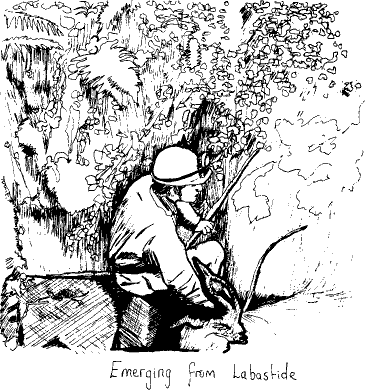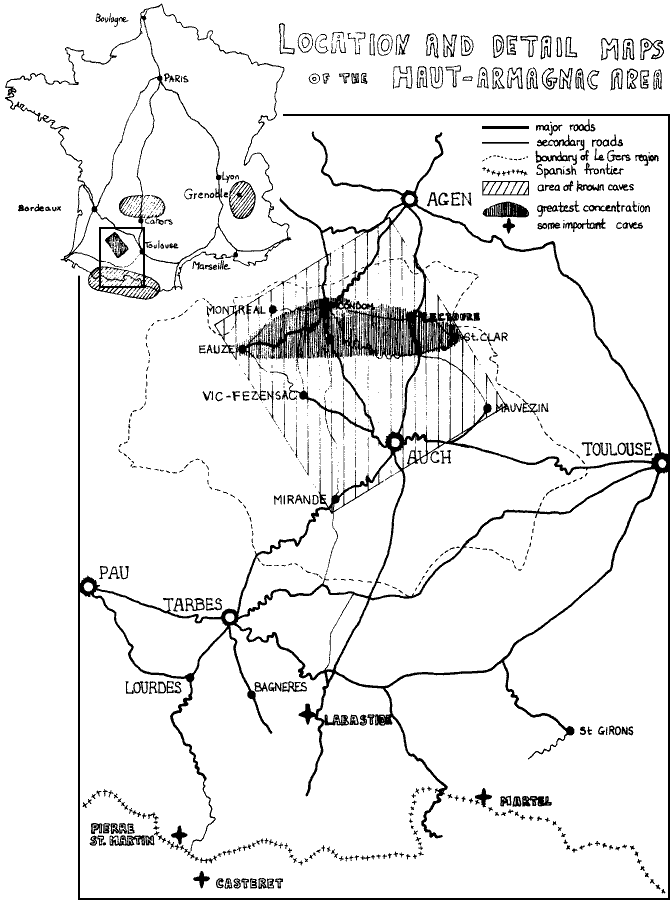Cambridge Underground 1979 pp 7-12
Caving with the Spéléo-Club de
Gascogne
Part I From Farmyard Well To Castaret's
"Labastide"
 I think I was pretty lucky to start my
caving in France - no water underground and beautiful weather above; I
remember that my first Club Meet, to Yorkshire, gave me the opportunity to
observe the true caving conditions more closely - only about a month after
this semi-tropical initiation ! I admit my affection for the British caving
life, but I have to declare a certain fondness for the French setting.
I think I was pretty lucky to start my
caving in France - no water underground and beautiful weather above; I
remember that my first Club Meet, to Yorkshire, gave me the opportunity to
observe the true caving conditions more closely - only about a month after
this semi-tropical initiation ! I admit my affection for the British caving
life, but I have to declare a certain fondness for the French setting.
I am fortunate to know, from many summers spent in SW France, a family
whose caving tradition goes back at least 30 years through the father, the
archetypal retired French peasant - beret, black jacket, collarless shirt
buttoned to the neck, baggy grey trousers and an incredible growth of beard
framing his blood-shot eyes and ruddy nose, a character who knows all there
is to know about his part of France. They are among the founder members of
the Spéléo-Club de Gascogne (1957) based
at Lectoure in the Gers region.
With the treasures of the Pyrenees only 4 hours away by car there is no lack
of opportunity, yet they have also found the time to open up the subterranean
secrets of their own neighbourhood, admittedly of a lesser importance.
Their major sortie each year, apart from occasionally nipping up to the
ice cave, Grotte Casteret, or the
Gouffre Martel, is a two week camp at the
Pierre St. Martin every August, involving complex
culinary arrangements - food being a very vital part of the lives of these
country people. When I was there at Christmas '77, they had their annual
dinner in a local cave which they have arranged to make an ideal chamber for
60 of us sitting at trestle tables. We enjoyed a marvellous 6-course meal,
cooked in a convenient alcove on camping-gaz, while wine and
Armagnac flowed liberally.
My first pot (undertaken at about 10.30pm on a weekday - quite a usual
time to go) was down a 10m well in a local farmyard with a fairly large
chamber of white limestone opening out at its base. The way on was a small
tortuous passage down to a short section of streamway and finally a humid and
extremely glutinous chamber with no way on. Hardly an inspiring start.
The second step in my caving career was, however, a slightly bigger one
just 10 days later. A five car party congregated in a layby above the valley
side where the entrance to Labastide (referred to as
Esparros by my companions, from the name of a nearby
village) snuggled in a dip on the tree-covered slope. A posse of gendarmes
who rolled by seemed curious at the sight of people undressing at the
roadside, but obviously assumed we were just a bit mad - not that there were
any wetsuits around; just claggies, the occasional spock-suit, and, most
impressive of all, a T-shirt, shorts and remains-of-plimsoles combination.
The latter was our our guide, an experienced caver as it turned out.
As we wandered down to the entrance, a few hundred yards from the road,
the Pic du Midi basked contentedly above us in the hot
summer sun, and the miniature cows way off down the valley just carried on
cropping the lush grass. The entrance shaft is in a corner of a deep
depression half filled with boulders around which we scrambled on greasy mud.
I remember the entrance pitch being quite a long one, though
Casteret (in Ten Years Under The Earth) suggests that
people and foxes were able to use the cave easily enough - perhaps my senses
were too busy absorbing the general atmosphere of the place. At the bottom of
this shaft is the entrance to a vast chamber with an enormous hole in its
floor, around which we traversed to the right. Our improvised lighting (those
flat torches common in France with a change of batteries - they last 2-3
hours) was working well, though they didn't light the bottom of that hole.
Using a single continuous rope loop as a sit-harness we were able to krab on
to a safety line for the exposed traverse, before we wandered off into huge,
dry boulder-strewn passages which would occasionally open up to become vast,
soaring chambers. The effect of these enormous subterranean spaces was such
that my attention only briefly fell on the cave art, though I remember seeing
one of the renowned horse engravings fairly early on in the trip. Some of the
curtains hanging from the distant roof seemed enormous, and the few unspoilt
stals (one of which had been glued back together !) and fields of hanging
straws in sheltered alcoves were fascinating.
When we reached the end of the tourist trip we were in a much smaller
chamber, from which a small tube led off to the right for a few feet before
being sealed by a concrete plug, blackened by the carbides of inquisitive
visitors, which, I was told, had been inserted under
Casteret's instructions to prevent anyone penetrating
to the precious cave art and formations beyond that had previously been
plundered irresponsibly.
We sat quietly in pitch darkness for a while to absorb the atmosphere
before heading slowly back, via a detour to the left of the hole in the first
chamber, through a tight but wide slot into another huge chamber littered
with boulders. We emerged into the green-treed amphitheatre to fresh air, and
an exotic French picnic up on the mountainside - a fantastic change of
setting where we could appreciate the glories of the massive mountains bathed
in sunlight, and reflect on the amazing caverns beneath us.
Part II The Haut-Armagnac Region (see maps)

The Gers (pronounce the 's' if you want to get a
taste of the local accent) is in the most productive agricultural region of
France, where vines, wheat, and maize grow in rich profusion, and the
Gascon tradition of gastronomy is also cultivated. The
scenery is of low rolling hills (max. 200m), heavily cropped and dotted with
the indigenous white stone houses. There is little surface limestone visible
as compared with the Tarn et Garon region which links
this area with the Dordogne to the north-east; there
the patches of limestone join to form the more typical limestone scenery.
The caves of this area can be active or fossil, but are predominantly
short and shallow (the limestone being at a depth of between 5-25m),
generally occurring where the stream course has been interrupted by a change
of relief, which is then cut through along a fault. The sink is the usual
penetrable entrance found in the Haut-Armagnac, while
caves in the surrounding areas can often be entered via the resurgence.
Where the cave has been formed in the above manner, the passages tend to
be sinuous and uninterrupted, not often tall enough to stand in and with few
formations. In the indigenous underground stream caves (where the water has
been collected below ground to form the source) the caves can be much larger,
with sizeable chambers, and various formations may be present. In general the
caves are nearly horizontal - sinuous passages suffer sharp changes of
direction as they take the line of least resistance through the rock, and the
caver is normally following the streamway.
The Spéléo-Club de Gascogne was
formed in 1957, with its headquarters at Lectoure, and
it has spent much of its time since then revealing the underground world of
the Haut-Armagnac region, many of the caves having
been dug into, giving a total of some 57 systems. Their most pleasing find
was amongst their first, and took a year's digging to reveal a development of
about 1100m, including formations, three large chambers (the largest measures
some 40m long, 15m wide, and 13m high), and the only example of passable
abandoned phreatic passage in the area. This is the Grotte de
Sinai, the most important cave of the area.
Nearer their HQ is the Grotte de Tane; unearthed by
minor quarrying operations, an entrance pitch drops as a fine free-hang about
10m into a large chamber, landing on a boulder ruckle which descends a
further 10m to the end wall. Back beneath the entrance pitch a large passage
leads to a boulder choke hiding a small chamber with no way on. The size of
the chamber and passage make its formation and lack of development both
puzzling and frustrating.
The deepest local cave (30m) is Cavet Blanc at
Marsolan, which is also fun to do late at night. Twin
freeclimbable 10m entrance pitches (gated for safety) lead quickly to a 3m
climb down which is very sporting on the return without assistance
(especially for short, round people !); a further 12m pitch down the side of
an impressive curtain leads to a small streamway which quickly sumps, and is
at present defying digging attempts.
The last of the caves I shall mention is called variously
Grotte de Mauvezin or Grottes de
Broustès; buried in the woods away from the road, it has two
entrances (8m pitch or horizontal stooping passage) and a central chamber 12m
x 15m x 4m high on two levels. Its interest lies in the fact that this is
where the club's annual dinner is held at the New Year - possibly the most
suitable surroundings for such an event
In addition, I should mention that cavers suffer the perennial problem of
access related to ownership of the cave rather than responsibility for
accidents below ground, against which the caver has to be insured. The most
important cave of the area, Sinai, is threatened with
closure because of the ownership problem - the land to a depth of 1m belongs
to the farmer. Needless to say, it is to be hoped that any such outcome may
be avoided.
I end by thanking the relevant members of the club for having introduced
me to the caving world, and acknowledge the source of the detailed
information included in this article as their own guide to the area,
'Gascogne Souterraine' by
Gérard Bianchi (1977), which I hope to have
correctly translated.
Tony Malcolm
 Index to Cambridge Underground
Index to Cambridge Underground
 Table of Contents for Cambridge Underground 1979
Table of Contents for Cambridge Underground 1979
 Back to CUCC top page
Back to CUCC top page
 I think I was pretty lucky to start my
caving in France - no water underground and beautiful weather above; I
remember that my first Club Meet, to Yorkshire, gave me the opportunity to
observe the true caving conditions more closely - only about a month after
this semi-tropical initiation ! I admit my affection for the British caving
life, but I have to declare a certain fondness for the French setting.
I think I was pretty lucky to start my
caving in France - no water underground and beautiful weather above; I
remember that my first Club Meet, to Yorkshire, gave me the opportunity to
observe the true caving conditions more closely - only about a month after
this semi-tropical initiation ! I admit my affection for the British caving
life, but I have to declare a certain fondness for the French setting.
